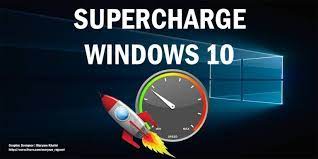Maximizing Efficiency: A Comprehensive Guide to Supercharge Windows 10 Performance

In the digital age, where speed and efficiency are paramount, optimizing your computer’s performance is essential for productivity and seamless user experience. Windows 10, Microsoft’s flagship operating system, offers a multitude of features and settings that can be fine-tuned to enhance performance and responsiveness. From optimizing system settings to managing startup programs, there are various strategies to supercharge your Windows 10 performance. In this comprehensive guide, we’ll explore a range of techniques and tips to help you maximize the speed and efficiency of your Windows 10 PC.
1. Keep Windows 10 Updated:
- Automatic Updates: Ensure that Windows 10 is set to automatically install updates to keep your operating system and drivers up to date.
- Security Patches: Regular updates not only improve performance but also patch security vulnerabilities, protecting your system from potential threats.
2. Optimize Power Settings:
- Power Plan: Adjust power settings to prioritize performance over energy saving. Navigate to Control Panel > Hardware and Sound > Power Options to select a high-performance power plan.
- Advanced Power Settings: Fine-tune advanced power settings to optimize performance further. Customize settings such as processor power management, minimum and maximum processor state, and system cooling policy.
3. Manage Startup Programs:
- Task Manager: Use the Task Manager to identify and disable unnecessary startup programs that consume system resources. Right-click on the taskbar and select Task Manager, then navigate to the Startup tab to manage startup programs.
- Startup Impact: Pay attention to the Startup Impact column in Task Manager to identify programs with a high impact on startup time and consider disabling them if they’re not essential.
4. Utilize Performance Troubleshooter:
- Built-in Troubleshooter: Windows 10 includes a Performance troubleshooter that can automatically detect and fix performance-related issues.
- Control Panel: Navigate to Control Panel > Troubleshooting > System and Security > Run maintenance tasks to access the Performance troubleshooter.
5. Optimize Visual Effects:
- Visual Effects Settings: Customize visual effects settings to improve performance. Right-click on This PC or My Computer, select Properties, then navigate to Advanced system settings > Advanced > Performance > Settings to access visual effects settings.
- Adjust for Best Performance: Select the “Adjust for best performance” option to disable all visual effects and prioritize system performance.
6. Disable Background Apps:
- Background Apps Settings: Prevent unnecessary apps from running in the background to conserve system resources and improve performance. Go to Settings > Privacy > Background apps to manage background app permissions.
- Disable Individual Apps: Toggle off the switch next to individual apps to prevent them from running in the background.
7. Perform Disk Cleanup:
- Built-in Tool: Use the Disk Cleanup tool to remove temporary files, system files, and other unnecessary data that may be cluttering your hard drive and slowing down performance.
- Access Disk Cleanup: Search for Disk Cleanup in the Windows search bar and select the tool to scan your system and free up disk space.
8. Defragment and Optimize Drives:
- Disk Defragmenter: Run the Disk Defragmenter tool to defragment and optimize your hard drives for improved performance and faster file access.
- Optimize Drives: Navigate to Settings > System > Storage > Optimize Drives to access the Optimize Drives tool and schedule regular optimization.
9. Upgrade Hardware Components:
- RAM Upgrade: Consider upgrading your computer’s RAM (Random Access Memory) for improved multitasking performance and overall system responsiveness.
- SSD Installation: Upgrade to a Solid State Drive (SSD) for faster boot times, quicker application launches, and improved file transfer speeds compared to traditional Hard Disk Drives (HDDs).
10. Monitor System Performance:
- Task Manager: Use the Task Manager to monitor system performance in real-time. Keep an eye on CPU, memory, disk, and network usage to identify potential bottlenecks and resource-intensive processes.
- Resource Monitor: Access the Resource Monitor tool for more detailed performance monitoring and analysis. Search for Resource Monitor in the Windows search bar to launch the tool.
11. Install Latest Device Drivers:
- Driver Updates: Ensure that all device drivers, including graphics drivers, chipset drivers, and network drivers, are up to date to optimize compatibility and performance.
- Device Manager: Use the Device Manager to check for driver updates and install the latest versions for each device. Right-click on This PC or My Computer, select Manage, then navigate to Device Manager to access device properties and driver updates.
12. Customize Virtual Memory Settings:
- Virtual Memory: Adjust virtual memory settings to improve system performance and prevent memory-related issues. Navigate to Control Panel > System and Security > System > Advanced system settings > Advanced > Performance > Settings > Advanced > Virtual memory to customize virtual memory settings.
- Manual Configuration: Consider manually configuring virtual memory settings by selecting the “Custom size” option and specifying initial and maximum size values based on your system’s RAM and storage capacity.
13. Enable Game Mode:
- Gaming Settings: Activate Game Mode to prioritize system resources for gaming applications and enhance gaming performance. Go to Settings > Gaming > Game Mode to toggle the Game Mode switch on.
14. Optimize Internet Settings:
- Network and Internet Settings: Customize network and internet settings to optimize connectivity and improve browsing and download speeds. Navigate to Settings > Network & Internet to access network settings and troubleshoot connectivity issues.
15. Regular Maintenance and Cleanup:
- Scheduled Maintenance: Schedule regular maintenance tasks, such as disk cleanup, disk optimization, and system updates, to keep your Windows 10 PC running smoothly and efficiently.
- Automation: Use built-in maintenance tools and third-party utilities to automate maintenance tasks and ensure optimal system performance with minimal manual intervention.
Conclusion:
In conclusion, optimizing Windows 10 performance requires a combination of strategic adjustments, regular maintenance, and proactive monitoring. By implementing the comprehensive guide outlined above, you can supercharge your Windows 10 PC to maximize speed, efficiency, and responsiveness. Whether you’re a casual user seeking smoother multitasking or a power user demanding peak performance for gaming or productivity tasks, these strategies will help you unlock the full potential of your Windows 10 system. So, dive in, customize your settings, and enjoy a faster and more efficient computing experience with Windows 10!







